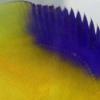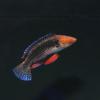-
Posts
16,553 -
Joined
-
Last visited
-
Days Won
29
Content Type
Profiles
Forums
Gallery
Everything posted by yikai
-
haha ok lor. yah lah if you happy can already.
-
ok i think this is what you should do. 1) throw away all the dying sea fans. seriously, what use are they? so unsightly and will not grow back. 2) get rid of all the small leather corals. they are so common and so ugly and nothing special. all these small rocks and small corals are just going to make things difficult for you. 3) get rid of all the lose rubble and small pieces of liverock. they are very difficult to scape with and are just going to cause problems. 4) there is no way you are going to succeed with doing a nice scape with all the existing pieces of rocks in your tank. don't touch the tank and visualise what kind of scape you want first. next, remove ALL the rocks from your tank. yes, all, and re-do the scaping once and for-all. one time stress the tank is better than small consecutive stress by constant rescaping. 5) let the final scape settle down and grow some coraline algae. the green and white rocks you have are not nice. in fact, why don't you just throw everything and get proper liverock? i understand you used dead and cooked rocks and it's going to take forever for it to look nice. dunno why u use dead rock? it's pointless. a little bit of crabs and worms ain't going to kill you. and last but not least, use BIG rocks! my tank only 9 rocks and its enough to scape everything fully liao. the bigger the better.
-
elegance flow too strong. and can you throw all those dying seafans away?
-
this is the worst of all the scape you have done! you better delete this before digiman see otherwise sure kena scolding lol. what happen to all the rocks? how come all so small.
-

OMG! Look at these hybrids and rare fishes!
yikai replied to Digiman's topic in FOWLR (Fish-only with Live-rock)
-

11-Oct-2010 to 18-Oct-2010
yikai replied to iskay's topic in Weekly LFS Stocks Report / LFS Info Centre
oh! sorry! did not see haha -

11-Oct-2010 to 18-Oct-2010
yikai replied to iskay's topic in Weekly LFS Stocks Report / LFS Info Centre
wat time? -

The world's fairy wrasses of the genus Cirrhilabrus
yikai replied to yikai's topic in FOWLR (Fish-only with Live-rock)
Cirrhilabrus exquisitus Exquisite fairy wrasse. Highly highly variable species with tremendous variants spanning Indonesia, Australia, Africa, Maldives, Fiji, Vanuatu and Japan. Very distinct colouration and differentiated via geographical variants. First pic shows an African specimen flashing. 2nd pic shows a Maldivian male flashing. 3rd pic shows a Fijian/Vanuatuan male flashing. Note the white anal fin when flashing and the 2 white saddles on the back (pink when non-flashing) 4th pic shows a Japan male flashing. Take note of the black patch on the dorsal fin. 5th pic shows an Indonesian male flashing. 6th and 7th pics show an Australian male flashing. 8th pic shows an African male specimen in non-excited state. This is the most commonly offered variant. -

The world's fairy wrasses of the genus Cirrhilabrus
yikai replied to yikai's topic in FOWLR (Fish-only with Live-rock)
Cirrhilabrus laboutei Labout's fairy wrasse. Great Barrier Reef and New Caledonia. Very distinctive colouration. This species has two prominant anal fin spikes that are very visible when anal fin is erected. First pic of a female, 2nd pic of a fully coloured male and last pic of a displaying male. Note the anal fin spikes. -

The world's fairy wrasses of the genus Cirrhilabrus
yikai replied to yikai's topic in FOWLR (Fish-only with Live-rock)
Cirrhilabrus scottorum Scott's fairy wrasse. South Pacific, Samoa to Pitcairn group. Very variable with plenty of geographical variations. Identified by distinct colouration and size. Geographical variants are differentiated by colour. Notoriously difficult to retain the colouration of male specimens. First pic from Cook Islands, middle pics from Fiji, last pic from Australia. Different colour variations. -

The world's fairy wrasses of the genus Cirrhilabrus
yikai replied to yikai's topic in FOWLR (Fish-only with Live-rock)
Cirrhilabrus jordani Flame fairy wrasse. Endemic only to the Hawaiian Islands. Males are readily identified by their large rounded fins and striking red and yellow colouration. When displaying, the body is outlined in purple. First pic of a female, 2nd pic of a male and last 2 pics of male flame wrasse in nuptial colouration. -

The world's fairy wrasses of the genus Cirrhilabrus
yikai replied to yikai's topic in FOWLR (Fish-only with Live-rock)
Cirrhilabrus johnsoni Johnson's fairy wrasse. Known only from the Marshall Islands, with all the main population being located in Kwajalein atoll, the largest atoll in Marshall Islands. Resembles the closely related C. lunatus but differs in having a red dorsal fin and anal fin. Gorgeous crescent tail. Recently only started re-appearing in the trade after a long hiatus, as Brian Greene is back from retirement, and collecting these gorgeous but expensive wrasses once again. -

The world's fairy wrasses of the genus Cirrhilabrus
yikai replied to yikai's topic in FOWLR (Fish-only with Live-rock)
Cirrhilabrus brunneus Dusky fairy wrasse. Indonesia and Philippines. Was thought to be a variation of C. lunatus, but recently described to be a new valid species based on colour difference. -

The world's fairy wrasses of the genus Cirrhilabrus
yikai replied to yikai's topic in FOWLR (Fish-only with Live-rock)
Cirrhilabrus lunatus Crescent-tail fairy wrasse. Southern Japan and may range much furthur south. Indonesian speciems tentatively identified as this species. Males have a dusky dorsal fin that turns blue during courtship. A lovely species with a gorgeous lunated tail. first pic female, 2nd pic of a harem of lunatus fairy wrasse, 3rd pic of a male and last pic of a male displaying nuptial colouration. -

The world's fairy wrasses of the genus Cirrhilabrus
yikai replied to yikai's topic in FOWLR (Fish-only with Live-rock)
Cirrhilabrus melanomarginatus Black-margin fairy wrasse. South China Sea, Philippines to southern Japan. Adults identified by black margin on dorsal fin and large size. Max size of around 15cm, adults sport a stout triangular tail with a pointed filament. Resembles Cirrhilabrus scottorum. first pic of female, rest are males. -

The world's fairy wrasses of the genus Cirrhilabrus
yikai replied to yikai's topic in FOWLR (Fish-only with Live-rock)
Cirrhilabrus katoi Kato's fairy wrasse. Known only from islands off the Izu peninsula and south to Kashiwajima. Occurs in lose groups and usually comprise of females with one or two males. Males are gorgeously decorated with colouful dots. -

The world's fairy wrasses of the genus Cirrhilabrus
yikai replied to yikai's topic in FOWLR (Fish-only with Live-rock)
Cirrhilabrus roseafascia Rose-banded fairy wrasse. Known from New Caledonia, Fiji, Coral Sea, Samoa, Philippines and Palau. Wide ranging but never common and rarely seen in it's own range. Deep water species, grows to 9 inches. A very beautiful but extremely aggressive fairy wrasse. -

The world's fairy wrasses of the genus Cirrhilabrus
yikai replied to yikai's topic in FOWLR (Fish-only with Live-rock)
Cirrhilabrus lanceolatus Lanceolate fairy wrasse, Long-tail fairy wrasse. Izu region, Okinawa, Japan. Deep-water species, resembles Cirrhilabrus roseafascia. Adults have a very long lanceolate tail and gorgeous emerald green fins. -

The world's fairy wrasses of the genus Cirrhilabrus
yikai replied to yikai's topic in FOWLR (Fish-only with Live-rock)
Cirrhilabrus joanallenae Pennent fairy wrasse. Sumatra, Java and Andaman Sea. Males look almost identical to C. rubriventralis, but have black ventral fins instead of red. -

The world's fairy wrasses of the genus Cirrhilabrus
yikai replied to yikai's topic in FOWLR (Fish-only with Live-rock)
Cirrhilabrus sp 3. Kenya fairy wrasse. Known only from Kenya. Very similar to C. rubriventralis but obviously different at the same time. Belongs to the "rubriventralis-complex". Undetermined species. -

The world's fairy wrasses of the genus Cirrhilabrus
yikai replied to yikai's topic in FOWLR (Fish-only with Live-rock)
Cirrhilabrus naokoae Naoko's fairy wrasse. Geographical range uncertain. Was shipped from Indonesia and thought to have originated from northwest Sumatra. Females are very very rare in the trade and are orange with two well defined lines. The dorsal fin of the Naoko's fairy wrasse is very unique in the "rubriventralis-complex". It has a pointed dorsal fin much like a shark. The body is red with a white belly and a yellow streak separating the two. The red colouration tends to fade to black in the aquarium. Unlike most other fishes, this was described not from the wild, but from the aquarium trade. It was described by Hiroyuki Tanaka and Jack Randall, and was named after Hiroyuki's wife, Naoko. 2nd last photo shows a female. Last photo of a displaying male. Tail turns bright blue. -

The world's fairy wrasses of the genus Cirrhilabrus
yikai replied to yikai's topic in FOWLR (Fish-only with Live-rock)
Cirrhilabrus cf morrisoni Known only from Bali and southern Sulawesi, Indonesia. Looks very similar and seems to be most closely related to C. morrisoni, but has red ventral fins instead. -

The world's fairy wrasses of the genus Cirrhilabrus
yikai replied to yikai's topic in FOWLR (Fish-only with Live-rock)
Cirrhilabrus morrisoni Morrison's fairy wrasse. Known from Hibernia Reef in the western Timor Sea, off the Australian coast. Males are distinctive with their black fins.



















































